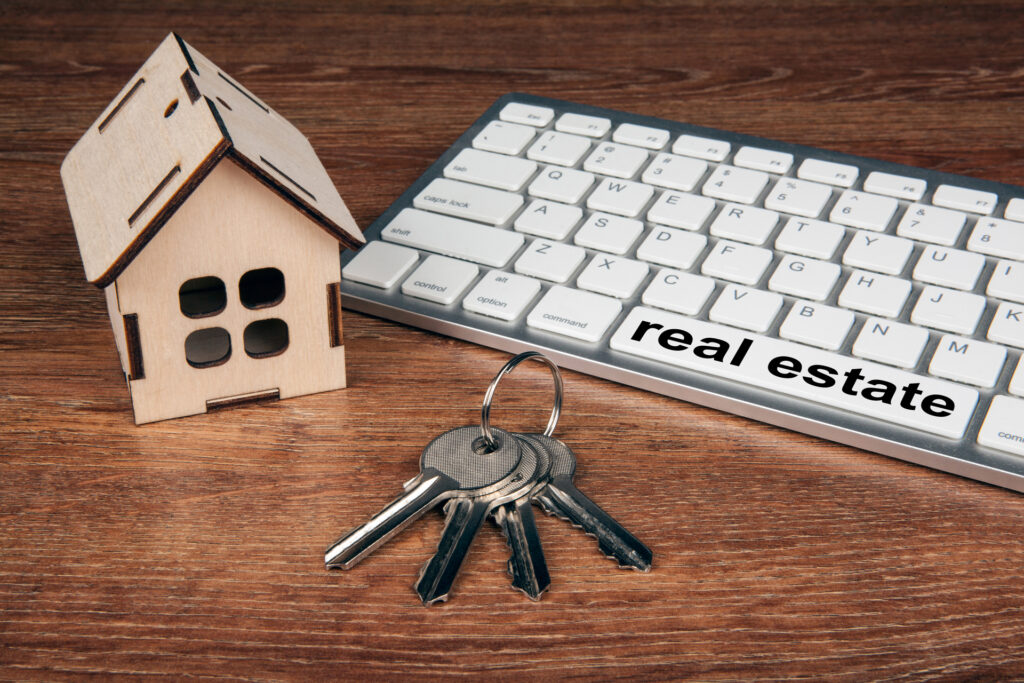Table of contents:
The real estate business is all about presentation. From fancy mansions to minimalistic apartments, you have an array of properties to display. Therefore, clients require enhanced methods to evaluate their preferred landed properties. That’s why professionals seek innovative methods to market their listings for maximum sales.
AR and VR have provided this solution in many ways. Their advanced technology opens a new world of possibilities for the property industry. Today, they lead the path to a new generation of real estate app development unseen in decades. Let’s examine how these advancements enhance marketing and sales.
Real Estate App Development Before AR and VR
The traditional real estate industry handled presentation needs without issues. Traditionally, the real estate industry listed properties through text-based and printed media. As time passed, pictures came into the mix showcasing different real estate specs to interested parties. Then, real estate app development focused on a closer property inspection through videos and stills.
However, despite their impressive nature, these efforts encountered numerous setbacks. The internet’s competitive nature meant realtors had to work with fast-paced presentations. Communication lags also made promoting listing options harder. In many cases, clients have to check buildings in person to confirm their preferred specs are available.
Then, competition forced more property listings to practice exaggeration. As more prospects flooded apps, the need to offer more effective pitches became paramount. Professionals face a challenge: crafting the ideal pitch without sacrificing quality. This pushed the average real estate app development company to adopt AR and VR.
How AR and VR Enhance Real Estate Businesses
AR and VR technology has influenced various sectors, including real estate. Their immersive nature gained much acceptance in education, retail, gaming, and healthcare. However, they also provided additional benefits to the development of real estate mobile apps. Below are a few:
- Better Property Visualization: AR in apps takes property viewing to another level with 360 showcase capabilities. They also combine interactive elements with 3D visualization, so clients can enjoy better listing experiences.
- Higher Customer Engagement and Satisfaction: The immersive nature of AR and VR apps makes them quite appealing. Better presentations and detailing drive customers to faster deal closures.
- Extensive Marketing Avenues: Apps with VR and AR allow a wider range of real estate marketing. From interactive brochures to augmented signage, professionals can display more properties at the same time.
- Deeper Client Behavior Analysis: Most VR apps include automated user data analysis. They collect data from prospect visits to calculate interests and behaviors. They input the results into the algorithms to improve future showcases.
- Optimized Operational Cost and Time: Customers can explore a variety of real estate options online through one AR app. This virtual advantage means you spend less time and money but close deals faster.
Key Real Estate Sections for AR/VR App Development
AR and VR technology has taken real estate mobile app development to greater heights. Their interactive features let users enjoy various experiences during property searches. It’s why their technology is integrated into the following real estate operations:
Property Listing
Rather than depend on physical visits, customers can explore listings through virtual previews. VR and AR apps use 3D overlays to present properties of all types online. Prospects can now analyze various options at their fingertips and get real-time insights.
Users don’t only observe showcases but can also make restructuring suggestions. You can compare materials and dimensions to find the right fit. They offer a personalized touch to a process often considered exhausting and generic.
Virtual Advertising
Traditional real estate app development uses customer online behavior to present ads. Therefore, unless a prospect conducts a specific search, the algorithm may not display similar listing offers on their screen. However, AR is transforming this situation by utilizing location-based ads that incorporate QR codes. Now, buyers can experience automatic inspections for potential properties they come across.
VR and AR apps also feature virtual tours, so prospects can explore properties through mobile apps. Some of these apps integrate with headsets, allowing users to fully immerse themselves in the 3D world. These virtual walkthroughs allow engagement with the property’s features. Some even let you check curtains and open drawers!
Architectural Projections
Virtual reality has been a driving force in modern architecture for years. But this advantage has also found its way into real estate marketing and sales. Property experts can display 3D models of properties and buildings to prospects through VR apps. The clients can get full insight into every aspect without needing to touch physical objects.
AR apps also let customers make required projections on repairs and upgrades. By selecting or requesting templates, they can request changes to a prospective property. Realtors can also project new designs on existing real estate to property owners without costly reworks.
Interior Decor Staging
AR and VR apps take online property inspection further with virtual interior decor suggestions. Say a prospect is interested in an offered apartment but wants to see how it fares with their designs. They can run staged decoration templates that allow them to change elements in the current space. These include:
- Furnishing
- Room resizing and repainting
- Wallpaper modifications
- Flooring options
- Customized wall decor
- Curtains, electronics, and so much more.
Clients can toggle through various design ideas to find the perfect option for the property. This interactive experience speeds up purchasing decisions, letting you make better sales.
Virtual Property Management
VR apps extend beyond real estate marketing and sales, offering various benefits for property management. Property owners can run maintenance and restructure suggestions using 3D models on these apps. Property managers can also share insights with tenants on possible redesigns through virtual staging.
This advantage works particularly well in short-rent cases, where reaching clients can be difficult. Realtors can engage tenants on dimensioning, interior decor specs, and other factors with the use of AR in apps. This collaborative communication fosters better agreements between stakeholders.
Effective Ways to Integrate AR and VR in Real Estate Apps
There’s no better time to infuse AR and VR technology into real estate app development. Their innovative experience enhances property business operations and sales. Plus, they make real estate dealings fun and engaging. Here’s how you can get the best out of them:
Choose the Ideal Tech Partner
You want maximum expertise when building real estate apps with VR and AR. It’s easy to feel overwhelmed by the abundance of options available in the market. But the right partner is one with reputable experience in the business and a solid team. Also, consider their previous projects and note the client testimonies.
You also need a tech partner who can work within a flexible budget. AR and VR technology can be costly when developing a real estate app. Pick a company that balances quality with affordability. Make sure their team takes your input into consideration at every stage.
Choose the Right Technology
Real estate apps work on an extensive variety of platforms, so consider this when planning one. You want your AR/VR app development to flow with the hardware they work on. Below are a few suggestions:
- ARCcore, Vuforia, and ARKit platforms for smartphones
- AR-enabled glasses integration
- AR framework engines (Unity, Blender, 3ds Max, Unreal Engine, etc.)
- 5G technology for faster network response
Keep It User-Friendly
Keep in mind that the typical prospect lacks a strong background in technology. So, maintain a simplified overlay for your real estate app development. Focus on a design that displays the features clearly and better. And reduce function steps so clients can reach their desired goals faster.
Also, decide the kind of app you’re building. You can choose between a narrative or interactive virtual tour. The former explains the property details as the user watches the displays. But the latter lets users experience the dimensions in real time using 3D models.
Optimize App Performance
Your AR app must be fast and responsive and feature the right elements. VR, especially, requires lots of time visualizing animated models. Therefore, neglecting optimization could potentially expose users to motion sickness and latency. It should also be open to all users, including those with disabilities.
Ensure your chosen real estate app development company runs continuous testing. Invest in quality assurance experts to check your app’s overall performance. Have them analyze the available features and review them for potential options. Let them keep your app updated with the latest tech trends and tools at every upgrade.
How We Can Help
North South Tech is aware of the rapid changes in property marketing. We implement AR and VR in real estate app development, delivering immersive experiences that enhance sales. With virtual tours, interactive 3D models, and customized interior staging, we provide more than property listings. We create cross-platform, user-friendly apps so your clients can view properties from anywhere.
Through this new technology, we help your real estate business stand out in a competitive market. North South Tech can revolutionize property displays online. Discuss your AR/VR app vision today to improve your real estate marketing approach.






